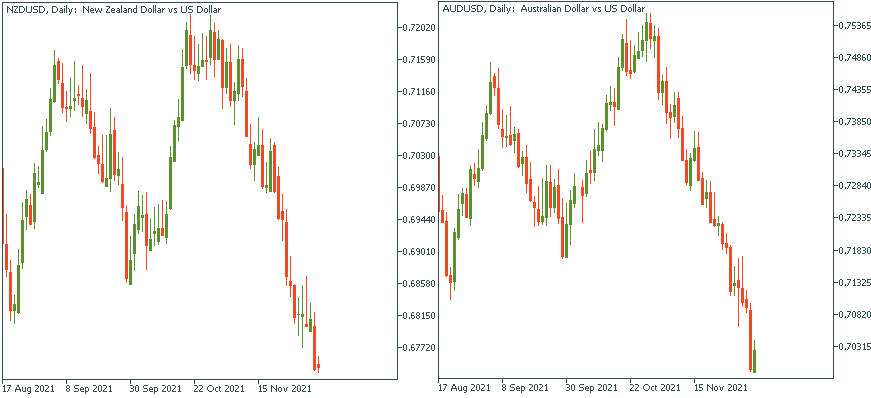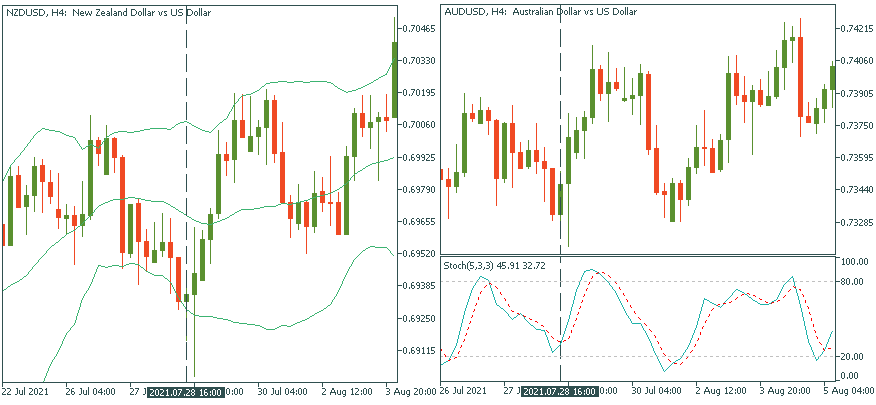What Is Forex Pair Correlation and How to Trade on It?
What is currency correlation in Forex trading?
Currency correlation in Forex is an essential thing that every trader should understand. Why? It can affect trading results without the trader’s awareness. In general, correlation is a mutual relationship between two or more things, while, in Forex, correlation is a connection between currency pairs. It reveals to what extent they move in one direction. The stronger the correlation is – the more related their price charts are. There are two types of correlation: positive and negative.
Positive correlation
A positive correlation means that two pairs move in the same direction.

Negative correlation
A negative or inverse correlation means that two pairs move in the opposite direction.

Note that if the pairs move randomly with no visible connection, it means that there is no significant correlation between them.
What is the correlation coefficient?
A correlation coefficient is a measurement that demonstrates how strong or weak a correlation is between currency pairs. The coefficient ranges from -1.0 to +1.0. Notice that you would hardly meet exactly -1.0 and +1.0 coefficients. Whereas numbers close to 1.0, such as 0.8 or 0.7, occur more often.
- The closer a number is to 1.0, the stronger the correlation is between currency pairs (the extent their values are related). Alternatively, the closer the correlation coefficient is to 0.0, the weaker the relationship between currency pairs.
- The ‘+’ sign shows the positive correlation (the same direction), while the ‘-’ sign signals the negative correlation (the opposite direction) between pairs.
What correlation is considered strong?
If the coefficient is below -0.7 and above +0.7, the correlation between currency pairs is widely accepted as strong. Otherwise, if it is between -0.7 and +0.7, it indicates that the pairs are weakly correlated. The correlation coefficients close to 0 demonstrate that the currency pairs have no detectable relationship.
Highly correlated currency pairs in Forex
This table reveals the most traded currency pairs with strong negative or positive correlations.
| Pair 1 | Pair 2 | Type of correlation |
| AUD/USD | NZD/USD | Positive |
| AUD/USD | GBP/USD | Positive |
| EUR/USD | GBP/USD | Positive |
| GBP/USD | GBP/ JPY | Positive |
| USD/JPY | GBP/ JPY | Positive |
| EUR/USD | USD/CHF | Negative |
| GBP/USD | USD/CAD | Negative |
| GBP/USD | USD/CHF | Negative |
| USD/CAD | EUR/JPY | Negative |
| USD/CAD | AUD/USD | Negative |
It is significant for every trader to monitor correlations in the Forex market. For example, traders could accidentally go long on (buy) USD/CAD and go short on (sell) EUR/JPY thinking they have opened two different trades. But, instead, these pairs tend to move in opposite directions since these currency pairs have a strong negative correlation. In this case, they would open almost equal trades. So, on the one hand, the trader can win on both trades, but, on the other hand, it risks losing on both, as USD/CAD and EUR/JPY are highly correlated.
Forex correlation trading strategies
Coping strategy
You know that AUD/USD and NZD/USD correlate positively from the information above. If you look at their price charts, you will see almost identical pictures. Here is the trick: when one is lagging, you can predict with a great possibility its future movement simply by looking at its twin.
Double-check strategy
If you open orders with correlated pairs, be cautious as you can increase the level of risk you take. For example, let’s say you buy two currency pairs that are positively correlated: AUD/USD and NZD/USD. If your forecast is correct, you will get a double profit. However, if the price goes against your expectations, it will also double the loss. How can a trader minimize this possible risk? Use signals from correlated pairs!
For example, if you analyze EUR/USD and think it can rise, don’t open the long order immediately. Instead, make the proper analysis of the correlated pair (for example, GBP/USD) to confirm your trading signal. Then, only if the analysis of GBP/USD or any other positively correlated pair gives a bullish signal too, you can go long on EUR/USD with greater confidence!
Hedging strategy
What about negatively correlated currencies? Traders can use them for hedging purposes! For example, a trader buys two currency pairs that are negatively correlated. If the forecast is incorrect and the first pair moves opposite the trader’s expectations, the second trade will offset the losses.
A hedge is an investment a trader makes to decrease the risk of opposite price movements in an asset.
Taking one more trade that tends to move in the opposite direction to the first position is a hedging strategy. For example, if currency pairs are positively correlated and traders want to hedge, they should consider buying the first one and selling the second one. Alternatively, if currency pairs are negatively correlated, and traders wish to hedge, they should consider buying or selling both pairs (opening convergent orders).
Example of Forex correlation trading
For instance, you open the NZD/USD chart and notice two signals to go long (buy): the pair dropped out the lower line of Bollinger Bands, and the candle formed a pin bar. Then you switch to the correlated currency pair – AUD/USD. Great! It shows the signal to buy too: the signal line of the Stochastic Oscillator crosses the dashed line from the bottom up. Using this signal, you could have got the double profit from NZD/USD and AUD/USD.

Correlation in stock and commodity markets
Not only currency pairs correlate, but also commodities, stocks, and stock indices! All they can correlate with each other as well as with currency pairs. For example, gold (XAU/USD) tends to have an opposite correlation with the US dollar and a strong positive correlation with silver (XAG/USD).
Meanwhile, crude oil (XBR/USD and XTI/USD) positively correlates with the Canadian dollar as Canada is the largest oil supplier to the US. Thus, when oil rises, CAD/JPY tends to go up, while USD/CAD tends to go down.
Besides, US stock indices such as S&P 500 (US500) and Nasdaq 100 (US100) have a strong positive correlation. Moreover, cryptocurrencies such as Bitcoin and Ethereum have a high positive correlation. Finally, speaking about stocks, when one large-cap stock rises, all other similar stocks from its sector move up too.
How to trade forex correlation pairs
From the information above, you have learned various approaches to use correlation. To start trading correlated assets, follow the following steps:
- First of all, be sure you’ve downloaded the FBS app or MetaTrader 4/5.
- Open an account in the FBS app or the MT5 account in your Trader area. Make a proper market analysis and choose an asset of your interest: currency pair, stock, or commodity.
- Choose a strategy from above and pick a correlated asset.
- Manage your risk properly with special tools such as Stop Loss and Take Profit orders, which can be especially useful in times of high volatility on the markets. Remember, though these tools do not protect you 100%, they help you minimize the possible risks.
- Open order and monitor it!
Bottom line
It is crucial to know how various currency pairs correlate with each other. As written above, some currency pairs and other assets move in one direction, while others – in opposite directions. Understanding correlation in the financial markets helps traders manage their risks more appropriately and gives a powerful tool to increase profit!
For beginners
If you are new to trading, a demo account will be a perfect start for you as it allows you to train trading without any risk. After you open it, you will get 10 000 virtual dollars. Besides, pay attention to the fact that the minimum deposit at FBS starts from just $1 on real accounts. You can start a trading career with little money. So, you can limit your risks while having a real chance to get profits on a real account!